Kia Carnival assumes role of ultimate cruiser
By John Gilbert
After writing about the joys of cruising, and taking a new Forester from Duluth to Cloquet, Minnesota, to visit Gordy’s Hi-Hat, the greatest drive-in restaurant in the universe, I realized I could make a series of “cruising” columns and probably never run out of topics. This week, for example, we can discuss the virtues of the newer-than-new 2022 Kia Carnival, which is so new it ran out from under its previous name.
The previous Kia Sedona was named after a very neat and mystical city in Arizona where, right now the temperature is probably 120 degrees. Kia apparently figured that since people have finally figured out that the Sedona was a minivan, they would gamble that nobody would know that the Carnival is also a minivan, just a fancier and more stylish one..
When is a minivan not really a minivan? Apparently, when the manufacturer renames it in hopes that naive customers, who don’t yet realize that a good minivan is much more versatile and economical than a comparable SUV, might see the light.
We all know the story, about how station wagons became the mode of transportation when a car lacked adequate size for a family, then the minivan burst on the scene and took over the family-hauler work of station wagons. When people got tired of minivans with all their efficiency, they started buying SUVs, and have continued over the last 20 years to make SUVs the popular choice as the contemporary family truckster.
But minivan makers, squeezed to near extinction, have held on, because there remains a smaller but still sizable segment of the market. Many knew well of the most popular Dodge Caravan and Chrysler Voyager, which pooled their talents and became the Pacifica as the top-end minivan from Dodge/Chrysler. Most people also know that Honda and Toyota, those fierce Japanese competitors, have battled with their minivans over the years, with the Honda Odyssey and Toyota Sienna both waging duels for popularity. And both are very impressive, by the way.
Fewer people seem to be aware that from Korea, Kia has been producing a very solid alternative in the Sedona, and if they aren’t aware of it now, they can forget about it, because the new Sedona is now called the Carnival. The new Carnival comes as close as you can get to proving that a rename can fool people into thinking that you’ve built an all-new alternative to the standard minivan.
The Carnival will be a 2022 year model, but it will be available almost as we speak. It is filled with features, not the least of which is an appearance that blends the best features of a minivan and an SUV, which makes it king of its own segment, if you will, while satisfying itself that it may, well, be the king of all minivans, whether reluctant or not.
The Sedona, in its day, was loaded with enough features to take on the Caravan, Sienna and Odyssey, because it felt strong and substantial, and Kia, partner with Hyundai, has had the benefit of very strong engines. The Sedona also benefits from the fact that Hyundai owns its own steel company, which is why Hyundai and Kia cars are loaded with high-strength steel in their build-quality, which gives them a head start in the safety category. So Sedonas always felt solid and safe, and Kia is happy to carry those features over to the new model.
Kia put the Carnival on an all-new platform, which feels solid and stable. We assume it is stronger and safer in its newer and stiffer body, and the company, which has a big power increase to handle its larger size. Hyundai/Kia has been dabbling in making exceptional, small 4-cylinder engines is venturing off in a new direction. Other companies are scrambling to catch up to the winning combination Hyundai/Kia have built into their new cars, and for 2022, Hyundai/Kia have come through with an all-new 3.5-liter V6 that has the same exquisite build quality of its smaller 4s and V6es,
In the Carnival, the engine produces 290 horsepower and 262 foot-pounds of torque, which is a lot for a vehicle of the Carnival’s size, and more than the similarly sized V6es frogmen Honda and Chrysler, and handily outrunning the Sienna, which comes only in a hybrid in its latest model. More power to Toyota for expanding its hybrid reach into minivan territory, but if you want towing power and the ability to accelerate away from a stoplight against a herd of new cars, the Carnival is the one you will most want to drive.
The Carnival is uniquely attractive, departing from the routine of a rectangular box by forming a wide groove that stands as the prominent pillar at the rear edge of the sliding side door. Its shaft of textured silver makes a slinkier design, angling upward from the rear pillar, then angling toward the fashionable strut.
The rear is neatly stylish as well, and the grille is formidable with a grille that fits nicely inside the headlights in a charismatic grille that seems better than virtually any SUV’s design.
The bucket seats are firm and supportive, and the occupants have all sorts of treats from sitting in favorable setting. For example, the second row buckets are every bit as impressive as a first class airline seat. You can slide the seat fore and aft, and it also reclines, and once you’ve reclined the backrest, you also can push a switch and cause the front end of the seat cushion to rise into a lounge-chair foot rest.
Now that you’re sitting in reclined and foot-resting comfort, you can click the two video screens on the rear of the first-row headrests and you can tune in to such attractions as Netflix or U-Tube, which puts normal video screen attractions to shame.
The second-row seats with the footrests are only on the top line seats, while the lesser seat feature has the benefit of greater seat rest distance, which also allows easier access to the third row seats in the 7-occupant capacity of heated and ventilated seats cushions and backrests. In normal cases, that may seem excessive, but in this summer of sizzling temperatures, that sort of cooling is greatly appreciated.
The new 3.5-liter V6 with the Carnival’s 8-speed automatic combines to provide spirited acceleration and highway force, compared to any available minivan, and it also covers a solid amount of trailer towing. Shifting is smooth and trouble-free, and with EPA estimates of 19 miles per gallon city and 25 highway, it is easy to attain the combined 22 mpg of average fuel economy. I got 24.7 miles per gallon in combined city-highway driving, with much of the tankful spent on Duluth’s steep hillside avenues.
All of the minivans rank high in safety, and Kia has the extra edge of the Hyundai/Kia factor of owning its own steel plant, and the Carnival features standard forward collision avoidance and pedestrian detection, blind spot warning and avoidance, cross-traffic collision warning and avoidance, parking distance warning in reverse, lane departure warning and lane keeping assist, lane following assist, high beam assist, and driver attention warning. In addition, rear occupant alert with motion detection, passenger safe-exit assist that uses blind spot detection radar to detect approaching vehicles, and live video displays of adjacent lanes in the instrument panel whenever such vehicles approach.
Among the over-the-top features in the top-line Carnival, the power sliding side doors and tailgate open at the touch of a switch, and if you open the tailgate, you can stash groceries or other parcels in the deep-well bin behind the third-row seats, and as you do it, you will hear a mild little chirping sound. The Carnival is notifying you that you don’t want to dawdle, because after chirping for a while, the tailgate intends to close and latch. It is called a “walk-away” feature, and it means you can simply walk away without worry, because the tailgate — or side doors — will close and latch on their own.
The Carnival SX Prestige model I test drove was loaded, an “Astra Blue” color that was sort of a blue-grey, and the interior was “Tuscan Umber,” whatever you might imagine that to be. The pleasant cooling air blowing through the seat cushions and backrests also does the same in the second row buckets, and the price, while based at $46,100 has so much standard equipment that the total sticker is $47,770. It may seem like a lot, but it is less expensive by a substantial amount than the top-of-the-line Sienna, Odyssey or Pacifica.
Of more than passing interest, I have driven versions of the new Pacifica, and I noticed in a recent Motor Trend magazine a comparison test of the top models of all four don’t-call-me-minivans, and the ranking came out with the Sienna fourth, the Pacifica third, the Odyssey second, and the Carnival first. That was impressive, because the car magazines usually praise the Korean companies for their technology, but usually stop short of all-out endorsements in comparison tests. Not this time.
The Carnival is fully loaded, and, with the ability to tune in to U-Tube or Netflix, and greater storage behind the third-row seats than in a Suburban, it just might be the greatest “cruiser-”mobile in the industry.
The new Carnival seems certain to be an overwhelming hit. And if it isn’t, maybe Kia can name the next one the “State Fair.”


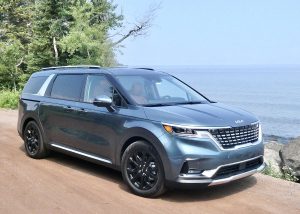
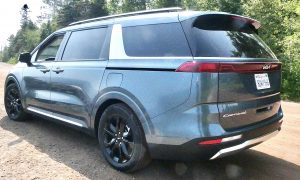
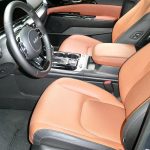
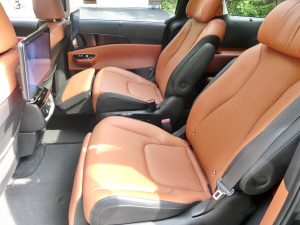
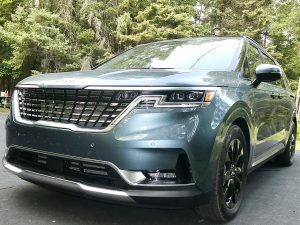
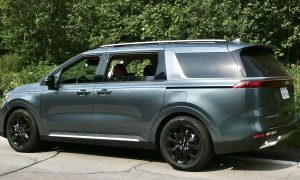
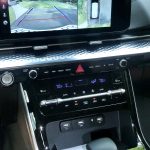
 John Gilbert is a lifetime Minnesotan and career journalist, specializing in cars and sports during and since spending 30 years at the Minneapolis Tribune, now the Star Tribune. More recently, he has continued translating the high-tech world of autos and sharing his passionate insights as a freelance writer/photographer/broadcaster. A member of the prestigious North American Car and Truck of the Year jury since 1993. John can be heard Monday-Friday from 9-11am on 610 KDAL(www.kdal610.com) on the "John Gilbert Show," and writes a column in the Duluth Reader.
John Gilbert is a lifetime Minnesotan and career journalist, specializing in cars and sports during and since spending 30 years at the Minneapolis Tribune, now the Star Tribune. More recently, he has continued translating the high-tech world of autos and sharing his passionate insights as a freelance writer/photographer/broadcaster. A member of the prestigious North American Car and Truck of the Year jury since 1993. John can be heard Monday-Friday from 9-11am on 610 KDAL(www.kdal610.com) on the "John Gilbert Show," and writes a column in the Duluth Reader.